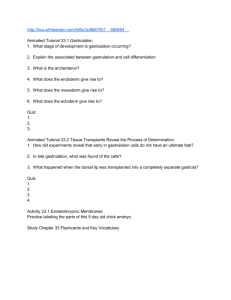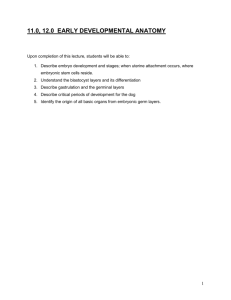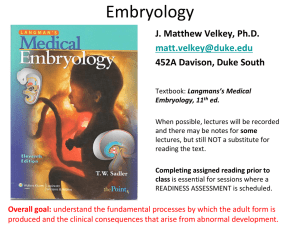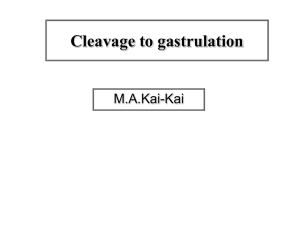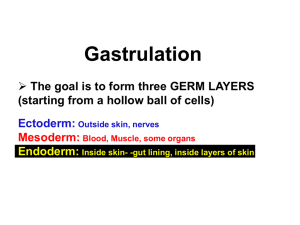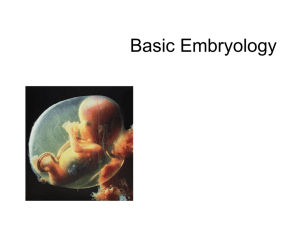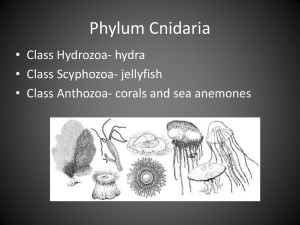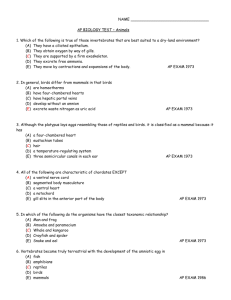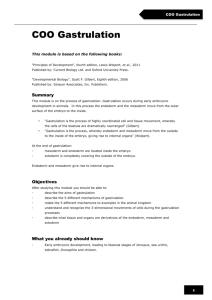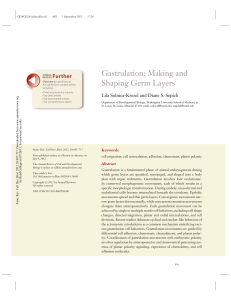Gastrulation: Formation of the Primary Germ Layers
advertisement
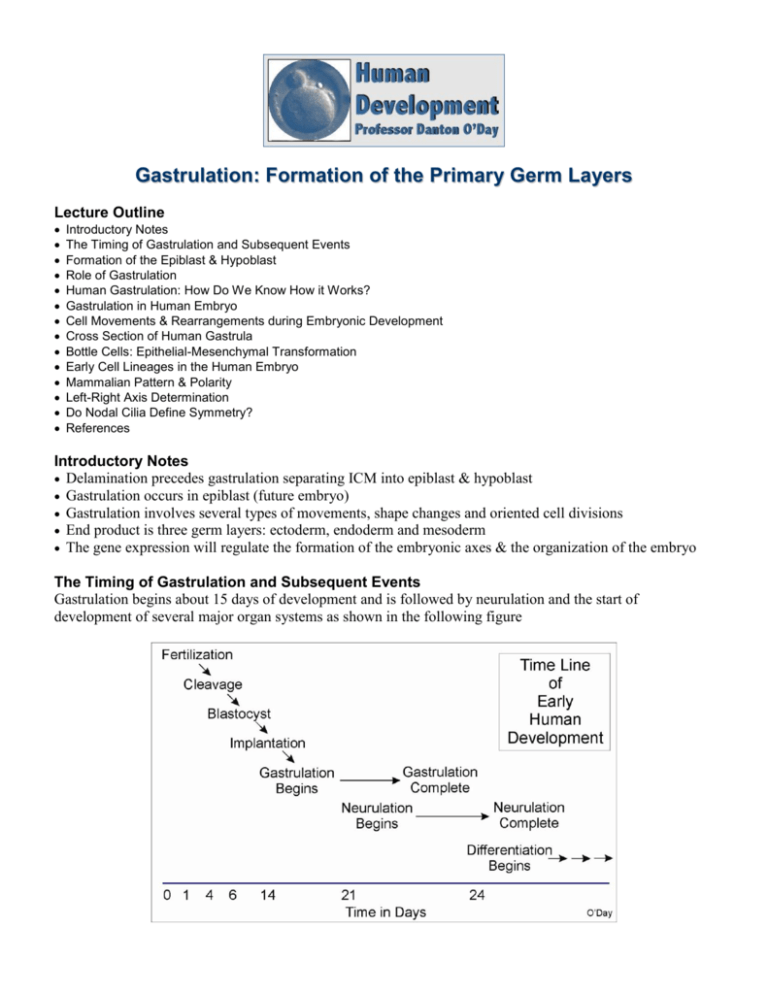
Gastrulation: Formation of the Primary Germ Layers Lecture Outline Introductory Notes The Timing of Gastrulation and Subsequent Events Formation of the Epiblast & Hypoblast Role of Gastrulation Human Gastrulation: How Do We Know How it Works? Gastrulation in Human Embryo Cell Movements & Rearrangements during Embryonic Development Cross Section of Human Gastrula Bottle Cells: Epithelial-Mesenchymal Transformation Early Cell Lineages in the Human Embryo Mammalian Pattern & Polarity Left-Right Axis Determination Do Nodal Cilia Define Symmetry? References Introductory Notes Delamination precedes gastrulation separating ICM into epiblast & hypoblast Gastrulation occurs in epiblast (future embryo) Gastrulation involves several types of movements, shape changes and oriented cell divisions End product is three germ layers: ectoderm, endoderm and mesoderm The gene expression will regulate the formation of the embryonic axes & the organization of the embryo The Timing of Gastrulation and Subsequent Events Gastrulation begins about 15 days of development and is followed by neurulation and the start of development of several major organ systems as shown in the following figure Gastrulation: Formation of the Primary Germ Layers Formation of the Epiblast and Hypoblast Once cleavage has resulted in the multi-celled blastocyst, morphogenetic movements will come into play to reorganize the embryo into distinct layers. The cells in the different layers will ultimately have different developmental fates. As we will see in more detail later, morphogenetic movements involve changes in the shapes of cells and often involve active movements of individual cells and groups of cells. As a result of these movements, new relationships will be set up between different groups of cells. The new relationships that result from gastrulation will allow new inter-cellular communications that are the cornerstone of embryogenesis. Most of our knowledge has been learned from mice and other mammalian species but current inroads into human morphogenesis are being made. The goal here is not to become proficient human embryologists but to understand the means by which morphogenetic movements occur and what their significance is to human embryogenesis. Inner Cell Mass (ICM) delaminates to form hypoblast and epiblast Occurs just prior to implantation & gastrulation Epiblast (green cells) is 2-layered (i.e., it is bilaminate) disc of approximately cuboidal cells & will form the embryo proper Flatter hypoblast cells lie below the epiblast and will form yolk sac Role of Gastrulation Gastrulation will covert the bilaminate epiblast into the three primary embryonic germ layers Ectoderm: outside; this embryonic layer more or less surrounds the other germ layers Mesoderm: middle; this germ layer lies between the ectoderm and endoderm Endoderm: inside; this germ layer lies at the most interior of the embryo Subsequently neurulation will form epithelial and neural ectoderm from the ectoderm Human Gastrulation: How Do We Know How it Works? Very little work has been done on human gastrulation Most work on fixed and stained human embryos No experimental work is being done on human gastrulation because it is not ethical or legal Therefore, difficulty getting specific stages Originally used knowledge from chick gastrulation: general morphology looks similar; more recently there has been extensive work on mouse embryos Page | 2 Gastrulation: Formation of the Primary Germ Layers Historically, mark embryos with particles & dyes to follow cell movements More Recently: Researchers have fluorescently labeled cells & followed their movement by confocal microscopy (a special laser-based microscopy which allows you to take optical sections through tissues to construct 3-D images) and obtain sharper resolution of stained material and its location. Gastrulation in Human Embryo Embryo is bilaminate (i.e., epiblast and hypoblast) Initially cells move along surface (blue arrows) but upon reaching the center line (primitive streak) will enter the embryo, turn the corner and move internally (red arrows). The moving surface cells first pile up to form a prominent bump known as the primitive node (also “node”). This occurs because the cells move along the top faster than they can separate off and move internally. It's sort of like crowds at a major concert. People stream into the venue from all over the city but pile up at the door before spreading out again once they're inside. The node was discovered in mammals by Hensen and is appropriately named Hensen's node in rabbits and other organisms but is only referred to as the “primitive node” or simply “node” in humans. The cells that enter through the primitive node will become the notochord (see lecture on neurulation). Page | 3 Gastrulation: Formation of the Primary Germ Layers As the cells continue to move in the primitive groove forms The cells that migrate internally first will become the endoderm which contains the presumptive notochordal tissue as well As the endoderm cells move in, they displace local hypoblast cells The last group of cells to move internally will migrate over the endoderm and form the mesoderm The cells that remain on the surface will form ectoderm and neural ectoderm The details of these movements are shown in the following sequence of pictures of 16 and 18day old embryos. Cell Movements & Rearrangements during Embryonic Development During human gastrulation, cells move over the blastodisc surface, enter the primitive streak and move internally. On the surface they move in association with other cells but once they turn the corner around the lip of the primitive streak the cells separate as individuals to migrate internally to form the mesoderm and endoderm. These are just some of the types of cell movements that occur in animal embryos. Here's a full list. Later we'll examine the shape changes that occur in the cells to carry out these movements. Page | 4 Gastrulation: Formation of the Primary Germ Layers Ingression: cells break away from the tissue and migrate as individuals (epithelial-mesenchymal transition during human gastrulation) Delamination: layers of cells separate from each others more or less as sheets of cells (formation of the epiblast/hypoblast) Intercalation: two cell layers interlace with each other Epiboly: a form of cell spreading in which cells flatten out; this allows them to cover a much larger surface area (1st detailed in frog development); surface of epiblast during gastrulation. Invagination (Evagination): a tissue layer folds in (out); optic (eye) vesicle formation Involution: cells move over a lip of tissue and into the interior Convergent Extension: cells reorganize to form less layers allowing the cells to extend out from a point; formation of the chordamesoderm (notochordal process). Page | 5 Gastrulation: Formation of the Primary Germ Layers Embryonic cell and tissue movements are driven by changes in cell shape, motility, size and number. Not all of these morphogenetic movements have been detailed in humans but they all have been shown to occur in other animals. Also remember, one type of cellular rearrangement does not exclude another with several different types of movement potentially occurring at the same time. Cross Section of Human Gastrula Bottle Cells: Epithelial-Mesenchymal Transformation Epiblast cells exist as an epithelium: essentially a tightly connected sheet of cells. As the cells prepare to migrate internally through the primitive note and primitive streak, they change shape to form a bottle like morphology (i.e., bottle cell). The final shape change converts them to a irregular, stellate shaped, mesenchyme cell. A mesenchyme is a large group of irregular shaped cells. Epithelial-mesenchymal transformations occur many times during development. Page | 6 Gastrulation: Formation of the Primary Germ Layers Bottle cells were first observed in amphibian gastrulation Occur during gastrulation in humans and many other species Also seen during neurulation and during other types of cellular rearrangements Involves a shape change from an epithelial morphology to bottle shape Involves a loss of cell-cell adhesion so cells can move as individuals; work has shown that this is due to the loss of E-cadherin Experiments with frog embryos have shown that isolated bottle cells show active movement in vitro Cells move internally under own motive force The way in which the bottle cells change shape and become motile is detailed in the next lecture on neurulation Mammalian Pattern & Polarity Humans, like most other living things, have a distinct organization. Thus the head is at one end while the feet are at the opposite end (Anterior-Posterior Axis; A-P axis). The face is one side (ventral) with the limbs and other body parts organized to function in this direction as opposed to backwards (dorsal) thus defining the dorsal-ventral axis. We also have right and left sides (Right-Left Axis). These three axes become established during early development and we are just beginning to understand how this comes about. Eyal-Giladi (1997. Development 124: 2286-2296) reviewed the classical literature dealing with the establishment of the vertebrate axis. Page | 7 Gastrulation: Formation of the Primary Germ Layers It is very likely that the anterior-posterior axis is established initially by implantation via mechanisms that remain to be elucidated. The establishment of the A-P Axis would in turn define the orientation of the primitive streak. In the mouse, the node that appears at gastrulation at the anterior end of the primitive streak contains information that oversees the construction of the whole body form. After the endoderm has migrated internally during gastrulation, a special region of extraembryonic endoderm called the "anterior visceral endoderm" instructs the formation of head components. Sonic hedgehog and nodal are important in defining and organizing the left axis of the embryo. The two signaling centres regulate gene expression in the different regions of the embryo to ensure that it develops with the relevant components in the right places at the right time. This is accomplished through the expression of genes appropriate to each region. For example, the protein activin functions during right axis development. It is a member of the TGF signaling family. Left-Right Axis Determination Let’s look at this topic in a bit more detail because it brings to the forefront some basic biological processes that historically were not considered by embryologists. The following diagram summarizes our understanding of how the left side of the embryo is determined and opens up some intriguing areas for further research. After Figure 3-2 from Larsen’s Human Embryology. Genes involved in establishing left-right symmetry. Initially Shh is expressed uniformly in the primitive node but over time it becomes expressed predominantly on the left side. This is followed by the increased expression of Nodal (a transforming growth factor beta, TGF, family member) on the left side of the primitive node. In turn, this is followed by the expression of another TGF, family member Lefty2. Finally the transcription factor Pitx2 is activated which presumably regulates a number of genes some of which are involved in lateral plate mesoderm differentiation. Other factors such as fibroblast growth factor 8 (Fgf8) plus Lrd and Kif which are mentioned below are also involved. Do Nodal Cilia Define Symmetry? The cell communication events mediating the development of the left axis are under analysis. Shh is a diffusible molecule that regulates signaling events in other cells. The nodal flow model suggests that morphogens and signaling molecules involved in defining the left-right axes is driven by the action of cilia that cause molecules to flow from right to left across the primitive node (see arrow in above diagram). In Page | 8 Gastrulation: Formation of the Primary Germ Layers mice and other mammals, cells in the node have been shown to possess a single cilium (monocilium) and mutations that affect ciliary action such as null mutations for Lrd (which encodes ciliary dynein) alter L-R symmetry. Figure 3-4 from Larsen’s Human Embryology. A. SEM of monociliated cells in mouse node. B. Nodal flow model involving NVPs and calcium ions. There are interpretations of the nodal flow model. One is that the cilia flow directs soluble morphogens and factors from right to left. While others suggest the Nodular Vesicular Particles (NVPs) are released from right cells and carried to those on the left by ciliary action. Either of these or even other events lead to higher calcium ion levels on the left which could direct left-side cell fate decisions. The nodal flow model gets support from the fact that mutations in ciliary dynein can lead to sinus inversus (i.e., right-left switching) for various organs (e.g., heart as seen in Kartagener’s syndrome). References Tam et al, 2006. Building the mouse gastrula: signals, asymmetry and lineages. Current Opinion in Genetics & Development 16: 419-425. Copyright 1998-2010 Danton H. O'Day Page | 9
